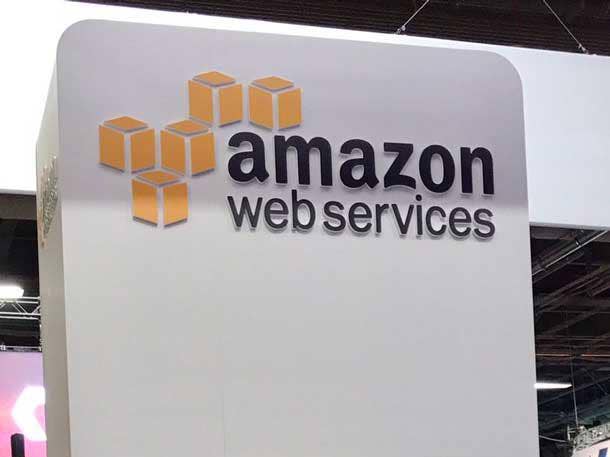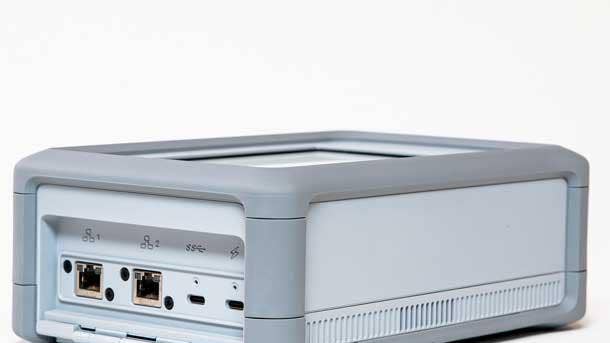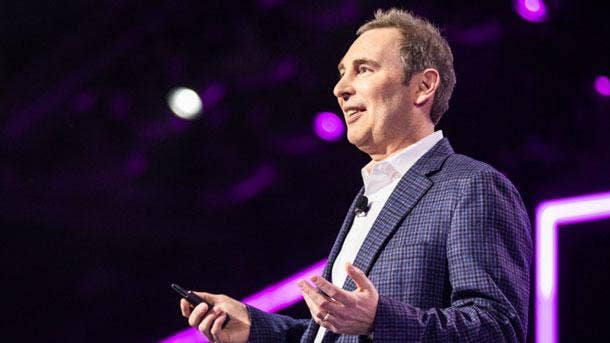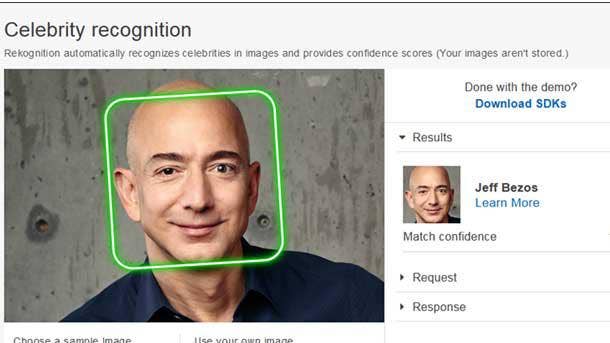The 10 Biggest AWS News Stories Of 2020 (So Far)
CRN looks at the largest cloud provider’s top headline-grabbing product releases and moves on issues ranging from JEDI to racial injustice to the coronavirus pandemic.

Amazon Web Services continued its fast pace of innovation and revenue growth this year, with first-quarter earnings that had it eclipsing a $40 billion annual run rate for the first time.
The Seattle-based cloud computing unit of tech giant Amazon – the largest among rivals Microsoft Azure and Google Cloud – introduced new AWS services and solutions ranging from the smallest member of its Snow line of portable edge devices to Amazon Honeycode, which allows customers to build mobile and web applications without writing programming code, to sixth-generation Amazon EC2 C6g and R6g instances powered by Arm-based AWS Graviton2 processors.
Several of the top AWS news stories so far in 2020 aligned with the top headlines nationally. AWS CEO Andy Jassy took to Twitter to comment on the unjust killings of Black people following the death of George Floyd while in the custody of Minneapolis police in May. Amid the sweeping protests that Floyd’s death ignited, AWS announced a one-year ban on police using Amazon Rekognition, its facial recognition technology.
AWS also is aiding research efforts to combat the deadly coronavirus (COVID-19) pandemic, committing $20 million to a new program focused on diagnostic solutions.
The company made some bold moves in its continued legal battle over the U.S. Department of Defense’s selection of Microsoft Azure -- instead of the highly favored AWS cloud -- for its potentially $10 billion Joint Enterprise Defense Infrastructure (JEDI) cloud computing contract, even seeking to depose U.S. President Donald Trump.
Here’s a look at the top 10 AWS news stories of the year to date, including how Jassy says video conferencing by remote workers has changed AWS thinking and how the cloud provider is increasing its stake in the “final frontier.”

10. Video Conferencing Changing AWS’ Thinking On Hiring, Meetings
AWS employees’ interactions by video conferencing while working remotely during the coronavirus (COVID-19) pandemic has changed the cloud provider’s thinking about hiring and how its meetings will evolve when more AWS employees return to its offices, CEO Andy Jassy said last month.
AWS, for a long time, wanted to hire people in locations where it had critical mass, because it was “easier for them to have the right career path and interact with their teammates more effectively and to have job mobility in a different way,” Jassy said during IT solution provider Presidio’s C-Suite Perspective Webinar Series last month.
“How effectively we‘ve all worked in a video conferencing environment has changed our view on where we hire people and whether it’s OK to have smaller numbers of people in more locations, as long as they’re willing to be available to collaborate with their teammates in a time frame that works for everybody,” Jassy said.
Meetings also may change. While AWS typically had employees all over the world appearing remotely by video for meetings prior to the pandemic, a larger number tended to be centered in one AWS location, and it was hard to fully include those remotely tuning in, according to Jassy.
“They‘re a little bit off on the side as opposed to the center of the meeting in person,” Jassy said.
But when everybody is attending by video conference, and each appears in a square on the video call, it changes the playing field, according to Jassy.
“It really levels it, and I think we‘ve found that it’s been more inclusive,” he said. “A lot of people who normally don’t get to participate as visibly are able to do so. It’s changed how we’ve been thinking about coming back to meetings when we get back into the office in larger numbers. There’s a lot of things that have happened during the pandemic -- most by necessity -- that are going to change the way we all work moving forward.”

9. AWS Snowcone Debuts
AWS last month announced the general availability of AWS Snowcone, a portable and rugged edge computing device for collecting, processing and transferring data to the AWS cloud from disconnected environments outside traditional data centers.
It’s the newest and smallest member of AWS’ Snow line of portable edge devices. Weighing 4.5 pounds, AWS Snowcone is about the size of a tissue box, so it’s small enough to fit in a conventional mailbox or small backpack, or to attach to a drone.
AWS Snowcone is an AWS-managed service, with AWS providing direct support to customers. It’s designed for remote or extreme conditions without consistent network connectivity or environments that require portability, including hospitals and first-responder vehicles, military operations, factory floors, oil rigs, remote offices and movie theaters. Industrial IoT, drones, tactical edge computing, content distribution, data migration, video content creation and transportation are among its use cases.
Snowcone includes support for AWS IoT Greengrass, the ability to run Amazon Elastic Compute Cloud (EC2) instances and local storage. It can be used as an IoT hub, data aggregation point, application monitor or lightweight analytics engine. Users can collect and process data and then move it from AWS Snowcone to the AWS cloud either offline by shipping the device to AWS using its E Ink shipping label or online using Ethernet or Wi-Fi with AWS DataSync, which are preinstalled on the device.
The other Snow products are the suitcase-size AWS Snowball and AWS Snowmobile, a 45-foot-long ruggedized shipping container that’s pulled by a semi-trailer truck.
Since it introduced the Snowball line in October 2015, customer use has greatly increased along with the need for a smaller device with more portability, according to AWS.
“With more applications running at the edge for an expanding range of use cases, like analyzing IoT sensor data and machine-learning inference, AWS Snowcone makes it easier to collect, store, preprocess and transfer data from harsh environments with limited space to AWS for more intensive processing,” said Bill Vass, AWS’ vice president of storage, automation and management services. “It‘s great for lightweight analytics on the edge. It’s got containers and EC2 instances on it, and it lets people connect to the cloud really easily.”

8. AWS Seeks To Depose Trump For JEDI Case
AWS asked a federal court to order U.S. President Donald Trump and Secretary of Defense Mark Esper to submit to questioning about potential political interference in the U.S. Department of Defense’s (DoD) award of the potentially $10 billion Joint Enterprise Defense Infrastructure (JEDI) cloud computing contract to Microsoft Azure last October, according to documents unsealed in February.
AWS wants to depose Trump about his reported statement to former Defense Secretary James Mattis to “screw Amazon” out of the JEDI contract.
“President Trump has repeatedly demonstrated his willingness to use his position as president and commander in chief to interfere with government functions – including federal procurements – to advance his personal agenda,” an AWS spokesperson told CRN in February.
AWS filed a lawsuit in November in the U.S. Court of Federal Claims, claiming Trump politically interfered in the contract deliberations due to his “disdain” for Amazon and CEO Jeff Bezos, who also owns The Washington Post newspaper.
The latest shots in the case came last month, when Frank Shaw, Microsoft’s corporate communications vice president, wrote a blog asking AWS to “stand down” from its litigation and protest of the commercial cloud transformation contract.
“…The Department of Defense’s decision to source a Joint Enterprise Defense Infrastructure contract to deliver the latest advancements in enterprise cloud could be a great step forward,” Shaw wrote. “But only if Amazon gets out of the way.”
AWS had filed “yet another protest” about Microsoft’s win with the DoD, according to Shaw, who characterized it as “likely yet another attempt to force a re-do, because they bid high and lost the first time.” AWS said it’s seeking clarity on how DoD officials are amending a request for proposals (RFP) that a federal judge found deficient on at least one factor related to how source-selection was evaluated for the JEDI initiative.
“The only thing that’s certain about Amazon’s new complaint is that it will force American warfighters to wait even longer for the 21st-century technology they need – perpetuating Amazon’s record of putting its own interests ahead of theirs,” Microsoft’s Shaw wrote.
But AWS said it wouldn’t back down.
“We don’t think the JEDI award was adjudicated fairly, we think political interference blatantly impacted the award decision, and we’re committed to ensuring the evaluation receives a fair, objective and impartial review,” Drew Herdener, Amazon’s vice president of worldwide communications, wrote in his own blog post.
In February, Judge Patricia E Campbell-Smith, who sits on the U.S. Court of Federal Claims, ordered Microsoft not to move forward with task orders and implementation of the cloud transformation initiative, citing a deficiency in Microsoft’s nearline storage capabilities. Campbell-Smith gave the DoD 120 days to further look into Amazon’s complaints about the evaluation of six technical criteria in the JEDI source-selection process. The DoD subsequently amended the RFP, but the changes were not made public.

7. AWS Seeks Bigger Space Race Stake
AWS is increasing its resources focused on the space race with the launch of a new aerospace and satellite solutions division created to win more military and commercial space organizations as customers of its cloud computing infrastructure and services.
Unveiled last month, the division will help transform space enterprises by working with customers and partners to reimagine space system architectures, launching new services that process space data on Earth and in orbit, and providing scalable cloud solutions to support government missions and private companies in the space industry.
Retired U.S. Air Force Maj. Gen. Clint Crosier, the former director of the U.S. Department of Defense’s planning for the U.S. Space Force – the newest branch of the military – will lead the new business segment, which will tap AWS’ already significant experience supporting commercial and government customers that design satellites and conduct spaceflight operations, according to Teresa Carlson, AWS’ vice president of worldwide public sector. The space landscape has dramatically shifted over the past 10 years, creating an enormous need for new types of innovation for space-based missions, Carlson said.
“New companies have moved into the space business and are launching more satellites and human missions into orbit than ever before,” Carlson said. “NASA continues to invest in developing a sustainable commercial space economy through Project Artemis. Low-latency internet, high-resolution Earth observation and ubiquitous internet-of-things communications companies will launch thousands of new satellites over the next five years to provide sensing capabilities to customers around the world.”
AWS Ground Station, which became generally available in May 2019 and is being used by NASA’s Jet Propulsion Lab and other customers, is an indication of the space solutions that AWS could develop, according to Carlson. Ground stations are facilities that use antennas to provide communications between the earth and satellites. AWS’ fully managed service allows satellite owners and operators to control satellite communications, uplink, downlink and process satellite data, and scale satellite operations.

6. The Launch Of Amazon Honeycode
AWS last month heralded the beta launch of Amazon Honeycode, which allows customers to build mobile and web applications without writing programming code.
Amazon Honeycode allows customers to bypass hiring developers – or resorting to emailing spreadsheets or documents -- to build often-costly custom applications for tasks ranging from approving purchase orders, inventory management and conducting simply surveys, to managing complex project workflows for multiple teams or departments, according to AWS.
Designed for non-professional “citizen” developers who are end-users inside enterprises, the fully managed service combines the familiar interface of a spreadsheet with the data management capability of an AWS-built database. Customers can use Amazon Honeycode’s visual application builder to create interactive web and mobile applications to perform tasks including tracking data over time, notifying users of changes, routing approvals and facilitating interactive business processes.
With the release, AWS joins Microsoft and Google Cloud in the no-code application competition.
But Gartner research vice president Jason Wong referred to Amazon Honeycode as functionally “very lightweight” in its initial release compared to Microsoft Power Apps, which launched in 2016, and Google Cloud’s AppSheet gained from the acquisition of the 6-year-old Seattle startup in January.

5. AWS CEO Andy Jassy: 6th-Gen EC2 Instances A ‘Game-Changer’
AWS CEO Andy Jassy called AWS’ new sixth-generation Amazon EC2 C6g and R6g instances powered by Arm-based AWS Graviton2 processors an expected “game-changer.”
First unveiled at AWS re:Invent in December, AWS made the new AWS-designed, compute-optimized C6g and memory-optimized R6g instances generally available last month.
“Excited to bring customers the next gen of Amazon EC2 instances powered by #AWS-designed, Arm-based Graviton2 processors that deliver up to 40% better price/performance than comparable current x86 instances,” Jassy tweeted. “Should be a game changer!”
The Amazon EC2 C6g and R6g instances currently are offered in AWS’ U.S. East (northern Virginia and Ohio), U.S. West (Oregon), Europe (Frankfurt), Europe (Ireland) and Asia Pacific (Tokyo) cloud regions.
AWS designed the C6g instances for compute-intensive workloads, including high-performance computing, batch processing, video encoding, gaming, scientific modeling, distributed analytics, ad-serving and CPU-based machine learning inference. The R6g instances are designed for workloads that process large data sets in memory, including open-source databases such as MySQL, MariaDB and PostgreSQL; in-memory caches such as Redis, Memcached and KeyDB; and real-time, big data analytics.
The new instances -- and general-purpose EC2 M6g instances rolled out in May – have a 40 percent better price-performance over comparable current-generation x86-based Amazon EC2 C5 instances. Built on the AWS Nitro System of AWS-designed hardware and software, they’re each available in nine instance types, including bare metal.
“This is a big step forward over our current instance types, and it‘s why we’re leading with Graviton,” said James Hamilton, vice president and distinguished engineer at AWS. “Even I was slightly surprised by the Graviton performance, despite the fact that I was there on day one. We have up to 64 cores, up to 25 gigabits per second of enhanced networking and up to 19 gigabits per second of EBS storage bandwidth.”
The Arm-based AWS Graviton2 processors allow for up to 7x greater performance, 4x more compute cores and 5x faster memory than the Arm-based EC2 A1 instances powered by AWS’ first-generation Graviton processor introduced a year ago.

4. AWS Surpasses $40 Billion Run Rate
AWS’ first-quarter performance – with net sales of $10.2 billion for the three months that ended March 31 – had Amazon’s cloud division exceeding a $40 billion revenue run rate at $40.876 billion.
AWS sales grew nearly 33 percent from $7.69 billion in the prior-year quarter, driven by large online services providers ramping their cloud spending amid the global coronavirus (COVID-19) pandemic, as CRN’s Joseph Tsidulko reported in April.
“We’ve continued to see a healthy adoption of our business and healthy usage not only in the United States but globally,” Amazon chief financial officer Brian Olsavsky told analysts during the first-quarter earnings call, noting AWS was well-positioned because of its breadth of customers. “There‘s millions of active customers from start-ups to enterprises to public sector. AWS products are helping in the government response to the virus crisis and are there for customers who are seeing their own demand spikes -- companies enabling video conferencing, remote learning and online health services, for example.”
Customers offering online gaming and entertainment also are seeing much higher growth and usage, Olsavsky said.
And building what customers need in the areas of machine learning, artificial intelligence and other key technology areas has yet to be impeded by pandemic, Olsavsky said.
AWS’ strong performance came even while business in other key industries, including hospitality and travel, contracted very severely and quickly.
“There‘s going to be a mixed bag on industries, and of course this will be tied to general economic conditions for the country and the world, quite frankly,” Olsavsky said.
But AWS’ backlog of future contracts continues to grow, and AWS’ basic value proposition -- including “having the most functionality, largest vibrant community of customers and partners having really proven operational and security experience” -- continues to hold true, he said.
*What* will it take for us to refuse to accept these unjust killings of black people? How many people must die, how many generations must endure, how much eyewitness video is required? What else do we need? We need better than what we're getting from courts and political leaders.
— Andy Jassy (@ajassy) May 30, 2020
3. AWS CEO Andy Jassy Decries Racial Injustice
AWS CEO Andy Jassy was among technology industry leaders who used Twitter and other social media platforms to denounce racism and racial injustice as protestors mounted large-scale demonstrations nationwide in outrage over the death of George Floyd, a 46-year-old Black man, while in custody of the Minneapolis police on May 25.
“*What* will it take for us to refuse to accept these unjust killings of black people?,” Jassy tweeted on May 30, when protests in Amazon’s headquarters city of Seattle took a violent turn. “How many people must die, how many generations must endure, how much eyewitness video is required? What else do we need? We need better than what we‘re getting from courts and political leaders.”
Bystanders that week captured video showing a Minneapolis police officer kneeling with his knee on Floyd’s neck for almost nine minutes before he died. Floyd had repeatedly told police that he couldn’t breathe. His death further heightened tensions and anger that erupted over the shooting deaths of Ahmaud Arbery in Georgia in February and Breonna Taylor in her own home in Louisville, Ky., in March. Both also were Black.
A May 31 tweet by AWS parent company Amazon stated that the “inequitable and brutal treatment of Black people in our country must stop.”
“Together we stand in solidarity with the Black community – our employees, customers and partners – in the fight against systemic racism and injustice,” the company tweeted.

2. AWS Bans Cops From Using Rekognition For One Year
Sweeping protests against police abuse prompted AWS to reverse course on law enforcement’s use of Amazon Rekognition, its facial recognition technology.
In June, AWS said it was implementing a one-year moratorium on police use of the artificial intelligence-enabled tool, while allowing organizations such as Thorn, the International Center for Missing and Exploited Children, and Marinus Analytics to continue using it to help rescue human trafficking victims and reunite missing children with their families.
“We’ve advocated that governments should put in place stronger regulations to govern the ethical use of facial recognition technology and, in recent days, Congress appears ready to take on this challenge,” AWS said in a blog post. “We hope this one-year moratorium might give Congress enough time to implement appropriate rules, and we stand ready to help if requested.”
AWS launched Amazon Rekognition in late 2016 as a tool to identify objects, people, text, scenes and activities in images and videos, as well as detect “inappropriate content.” Its facial analysis and search capabilities can be used to detect, analyze and compare faces and perform a sentiment analysis to determine if a person is smiling or frowning.
Jassy previously had defended law enforcement’s use of Amazon Rekognition, while calling for federal government regulation of how it should be used and ramifications for misuse in lieu of having “50 different laws in 50 different states.” AWS strongly recommends that its law enforcement customers refrain from using results unless they are backed by at least 99 percent confidence levels and then only as “one piece of a human-driven decision like any other piece of evidence,” Jassy said in a prior interview.
“We believe that governments and the organizations that are charged with keeping our community safe have to have access to the most sophisticated modern technology that exists,” Jassy said during the “Frontline” documentary, “Amazon Empire: The Rise and Reign of Jeff Bezos,” that aired on PBS television stations in February. The program noted allegations that Amazon Rekognition wasn’t market-ready and police were “essentially field testing it on the public on behalf of the company” without clear regulations governing its use.
“We’ve never had any reported misuse of law enforcement using the facial recognition technology,” Jassy said during the “Frontline” interview. “At the end of the day, with any technology…the people that use the technology have to be responsible for it. And if they use it irresponsibly, they have to be held accountable.”
But Jassy said the vast majority of police departments are using it according to Amazon’s prescribed guidance, and when they’re not, “we have conversations, and if we find that they‘re using in some irresponsible way, we won’t allow them to use the service and the platform.”
AWS’ about-face came one day after IBM CEO Arvind Krishna said Big Blue had stopped selling facial recognition software and opposed the use of any technology for mass surveillance, racial profiling or violating human rights.

1. AWS Backing Coronavirus Efforts
AWS launched the AWS Diagnostic Development Initiative in March, committing $20 million to help customers’ research and development of diagnostic solutions for rapid and more accurate detection of the coronavirus (COVID-19) and future infectious disease outbreaks.
The initiative launched with participation from 35 research institutions, startups and businesses focused on accurate detection.
Funding is being provided through AWS in-kind credits and technical support to accredited research institutions and private entities that are AWS customers and using is cloud to support research-oriented workloads for the development of point-of-care diagnostic testing that can be done at home or at a clinic with same-day results.
Diagnostics research has been underfunded and deprioritized historically in favor of a focus on vaccines, Teresa Carlson, AWS’ vice president of worldwide public sector, wrote in a blog post. Carlson said AWS’ services including analytics and machine learning can help researchers more quickly process and analyze data.
“Better diagnostics will help accelerate treatment and containment and, in time, shorten the course of this epidemic,” Carlson said. “The AWS Diagnostic Development Initiative will benefit from the counsel of an outside technical advisory group consisting of leading scientists, global health policy experts and thought leaders in the field of infectious disease diagnostics.”
AWS also is collaborating with the World Health Organization (WHO) to use cloud technologies to track the virus, understand the outbreak and contain the spread. WHO has been leveraging the AWS cloud to build large-scale data lakes, aggregate epidemiological country data, rapidly translate medical training videos into different languages and assist global healthcare workers as they treat patients. AWS made public its own AWS COVID-19 data lake, a centralized repository of up-to-date, virus-related information for experts to use.